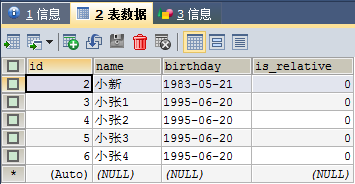

基于Python 轻量级ORM框架
描述
ORM框架使用最广泛的就是SQLAlchemy和Django自带的ORM框架,但是SQLAlchemy的语法显然相对Django的ORM框架麻烦一点。
而Django本身是一个web框架,比较重量级,仅仅为了使用Django的ORM框架的功能,而安装Django有点导致系统臃肿。而peewee这个框架语法几乎与Django的ORM框架一致,而又非常轻量。
它的安装非常简单:
pip install peewee
如果你在使用mysql数据库的过程中报出如下错误:
peewee.ImproperlyConfigured: MySQL driver not installed!
则需要安装一个mysql的驱动:
pip install pymysql
peewee的whl包是880kB,pymysql的whl包是51KB,非常轻量级。
peewee的官方文档地址:http://docs.peewee-orm.com/en/latest/index.html
下面测试一下各项功能:
from peewee import *
db = MySQLDatabase('test', host="localhost", user='root', passwd='123456', port=3306)
# 定义Person
class Person(Model):
name = CharField()
birthday = DateField()
is_relative = BooleanField()
class Meta:
database = db
def test_create():
Person.create_table()
# 创建多张表也可以这样
# database.create_tables([Person])
def test_insert():
# 添加一条数据
p = Person(name='小华', birthday=date(1996, 12, 20), is_relative=True)
p.save()
def test_delete():
# 删除姓名为perter的数据
Person.delete().where(Person.name == 'perter').execute()
# 已经实例化的数据, 使用delete_instance
p = Person(name='小华', birthday=date(1996, 12, 20), is_relative=False)
p.id = 1
p.save()
p.delete_instance()
def test_update():
# 已经实例化的数据,指定了id这个primary key,则此时保存就是更新数据
p = Person(name='小华', birthday=date(1996, 12, 20), is_relative=False)
p.id = 1
p.save()
# 更新birthday数据
q = Person.update({Person.birthday: date(1983, 12, 21)}).where(Person.name == '小华')
q.execute()
def test_query():
# 查询单条数据
p = Person.get(Person.name == '小华')
print(p.name, p.birthday, p.is_relative)
# 使用where().get()查询
p = Person.select().where(Person.name == '小华').get()
print(p.name, p.birthday, p.is_relative)
# 查询多条数据
persons = Person.select().where(Person.is_relative == True)
for p in persons:
print(p.name, p.birthday, p.is_relative)
下面测试一个各个方法。
测试创建表:
if __name__=="__main__":
Person.create_table()
执行完毕,检查数据库成功创建下面这张表:

测试插入数据:
if __name__=="__main__":
p = Person(name='小华', birthday=date(1996, 12, 20), is_relative=True)
p.save()
执行完毕后,表数据多了一行:

测试查询数据:
if __name__=="__main__":
p = Person.get(Person.name == '小华')
print(p.name, p.birthday, p.is_relative)
结果:
小华 1996-12-20 True
测试删除数据:
if __name__=="__main__":
Person.delete().where(Person.name == '小华').execute()
执行后,数据库对应的记录被删除:

测试修改数据:
if __name__ == "__main__":
p = Person(name='小新', birthday=date(1995, 6, 20), is_relative=False)
p.save()
# 更新birthday数据
q = Person.update({Person.birthday: date(1983, 5, 21)}).where(Person.name == '小新')
q.execute()
执行后:

测试批量查询:
if __name__ == "__main__":
for i in range(1, 5):
p = Person(name=f'小张{i}', birthday=date(1995, 6, 20), is_relative=False)
p.save()
# 查询多条数据
persons = Person.select().where(Person.is_relative == False)
for p in persons:
print(p.name, p.birthday, p.is_relative)
执行后:

结果:
小新 1983-05-21 False
小张1 1995-06-20 False
小张2 1995-06-20 False
小张3 1995-06-20 False
小张4 1995-06-20 False
更多用法可参考官方文档。
声明:本文内容及配图由入驻作者撰写或者入驻合作网站授权转载。文章观点仅代表作者本人,不代表电子发烧友网立场。文章及其配图仅供工程师学习之用,如有内容侵权或者其他违规问题,请联系本站处理。
举报投诉
-
一个面向嵌入式系统的轻量级框架2023-09-01 1012
-
Python爬虫与Web开发库盘点2018-05-10 2560
-
10个轻量级框架2019-07-17 2429
-
轻量级的ui框架如何去制作2021-07-14 1121
-
Dllite_micro (轻量级的 AI 推理框架)2021-08-05 2006
-
如何自制轻量级单片机UI框架?2021-10-14 2497
-
原创分享:自制轻量级单片机UI框架2021-11-05 1740
-
TinyDB轻量级数据库有哪些特点呢2022-10-28 2541
-
SQLAlchemy 2.0.0正式发布,Python ORM框架2023-01-31 836
-
一个纯Python编写的轻量级数据库2023-02-24 1759
-
测评分享 | 如何在先楫HPM6750上运行轻量级AI推理框架TinyMaix2022-12-12 2515
-
一个轻量级的权限认证框架:Sa-Token2023-09-30 4139
-
Mara-pipelines:轻量级的数据转换框架2023-10-30 1252
-
超级方便的轻量级Python流水线工具2023-10-31 1404
-
深度详解嵌入式系统专用轻量级框架设计2024-04-27 1845
全部0条评论

快来发表一下你的评论吧 !

